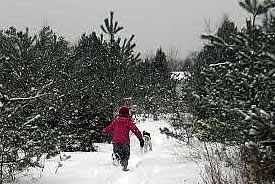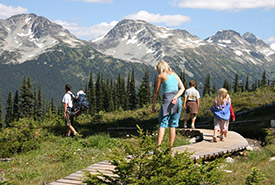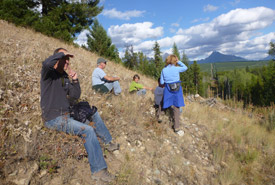Leave only footprints: Minimizing your impact in nature

Grace and Pepper exploring the winter wonderland (Photo by NCC)
Nature has been my greatest teacher. As a child growing up in the semi-desert of the Okanagan in British Columbia, I learned not to touch prickly pear, which plants smelled the most like sage and to move away from the warning rattle of a rattlesnake.
Riding my bicycle along the Kettle Valley Railway immersed me in an encyclopedia of sights, sounds and smells. It was this time during my childhood — climbing cherry trees to study the bugs and birds, collecting ponderosa pine cones for neighbourhood battles — that rooted the importance and magic of the natural world into my subconscious and led me to become the conservation-minded person I am today.

Family hiking near the mountains (Photo courtesy ParticipACTION)
In Canada, opportunities to connect with the natural environment abound. The Nature Conservancy of Canada (NCC) stewards the natural values on hundreds of conservation areas across the country; eight out 10 Canadians live within 100 kilometres of at least one of these areas.
NCC, like other land managers and organizations, takes pride in connecting people to nature and inspiring a greater understanding of the importance of conservation, while protecting the natural values that it promotes. Most of NCC’s conservation areas are open to the public, while a special few are kept closed in order to protect their sensitive natural features. This unique balancing act between conservation and recreation can be achieved through respectful actions of those visiting nature.

NCC staff exploring Flathead, BC (Photo by NCC)
With the celebration of Canada’s 150th birthday and free access to Canada’s National Parks this year, it is expected that more Canadians than ever will be venturing out into the great outdoors. It is the responsibility of all of us — visitors and land managers alike — to ensure we are demonstrating our respect for nature.
Here are some tips that I follow when I venture out into nature:
- Learn about a place before you go so that you are properly prepared for the terrain and weather conditions;
- Follow signs and instructions on how to behave on trails, in campgrounds and with wildlife;
- Stay on designated trails. Blazing new trails damages the natural habitat and can disturb wildlife;
- Respect any restrictions on vehicle access, including bikes;
- Pack out any garbage;
- Respect wildlife by not approaching or feeding wild animals;
- Keep dogs under control, or even better, on a leash;
- Share what you learned from nature with others.
Practising these good habits ensures wilderness stays wild.
One thing I always consider when in the outdoors is to leave only footprints and take only memories (and photographs). I reap the rewards while getting my dose of vitamin N(ature) through health-boosting exercise on designated trails, experience joy at wildlife sightings through my binoculars and feel pride as I build my plant identification catalogue through photographs. I also feel a sense of rejuvenating peace at being a part of the natural world.
Knowing that I am leaving nature in the same, if not better, state as I entered it ensures I may return again to enjoy the diverse natural wealth that Canada offers.


